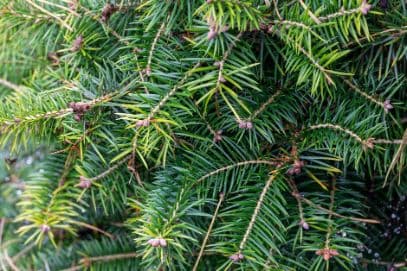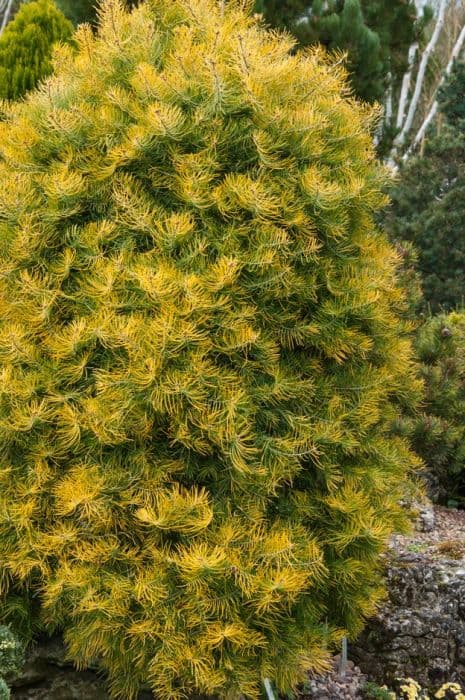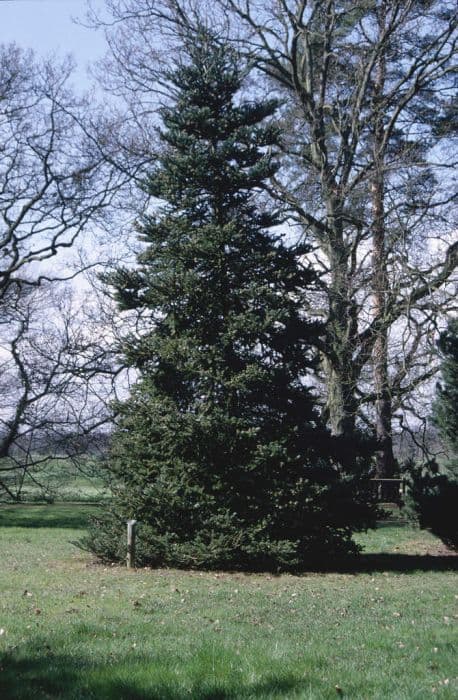Colorado Blue Spruce Picea pungens (Glauca Group) 'Koster'

ABOUT
The plant known as 'Koster' is a cultivar from the Glauca Group of blue spruce. This ornamental conifer is admired for its striking appearance, characterized by its unique silvery-blue to powdery-blue needle-like foliage. The needles themselves are quite sharp and pointed, hence the species name "pungens" which means sharp in Latin. Each needle is individually attached to the branches in a spiral pattern, creating a full and somewhat bushy texture. The overall shape of the 'Koster' plant is pyramidal with horizontal branches that typically curve upwards at the ends, giving it a slightly tiered and graceful profile. This curvature of the branches adds to the elegance of its silhouette in the landscape. Notable for its rich color, this blue spruce cultivar is often chosen as a focal point in garden design for its picturesque qualities and the beautiful contrast it provides against green-leaved plants or when dusted with snow. The cones of 'Koster' are also attractive, starting out as small, purplish reproductive structures before maturing to a woody, light brown color as they age. These cones are usually found hanging from the branches, adding yet further interest to the plant's appearance throughout the seasons.
About this plant
 Names
NamesSynonyms
Colorado Blue Spruce, Koster Blue Spruce, Koster's Colorado Spruce, Koster's Spruce.
Common names
Picea pungens 'Koster', Picea pungens var. glauca 'Koster'.
 Toxicity
ToxicityTo humans
The plant in question, commonly known as Colorado Blue Spruce, is generally not considered toxic to humans. However, ingesting parts of the plant may cause mild gastrointestinal issues, such as stomach pain or diarrhea. No severe toxicity is associated with this plant, but as with any non-edible plant, it is not advisable to consume it.
To pets
Colorado Blue Spruce is also not known to be toxic to pets. If a pet ingests parts of this plant, they may experience mild gastrointestinal discomfort, which could manifest as vomiting or diarrhea. It is always best to prevent pets from eating ornamental plants as a precaution.
 Characteristics
CharacteristicsLife cycle
Perennials
Foliage type
Evergreen
Color of leaves
Blue-green
Height
30-50 feet (9-15 meters)
Spread
10-20 feet (3-6 meters)
Plant type
Tree
Hardiness zones
2-8
Native area
Rocky Mountains
Benefits
 General Benefits
General Benefits- Aesthetic Appeal: Colorado Blue Spruce 'Koster' adds visual interest to landscapes with its unique silvery-blue needles and pyramidal shape.
- Privacy Screen: It serves as an effective natural privacy screen when planted in rows or groups.
- Windbreak: The dense foliage can act as a windbreak, protecting other plants and reducing wind speed in gardens and properties.
- Habitat for Wildlife: It provides shelter and nesting sites for birds and other small wildlife.
- Year-Round Interest: This evergreen keeps its foliage throughout the year, providing color and structure in all seasons.
- Drought Tolerance: Once established, it has good resistance to drought, reducing the need for frequent watering.
- Cold Hardy: It can thrive in cold climates, making it a suitable choice for northern gardens.
- Low Maintenance: Requires minimal pruning and care once established, making it a good choice for those seeking a low-maintenance landscape.
- Soil Adaptability: Can grow in a variety of soil types, although it prefers well-drained, acidic soils.
 Medical Properties
Medical PropertiesThis plant is not used for medical purposes.
 Air-purifying Qualities
Air-purifying QualitiesThis plant is not specifically known for air purifying qualities.
 Other Uses
Other Uses- The Colorado blue spruce 'Koster' can be harvested for its wood, which is used for paper production, construction, and carpentry due to its lightweight and moderate strength.
- The tree's symmetrical shape and dense foliage make it an ideal choice for privacy screens or windbreaks in residential and commercial landscapes.
- Resinous extracts from Colorado blue spruce can be used in natural perfumery for their distinct forest-like scent.
- Wood from 'Koster' is sometimes used in the manufacturing of musical instruments for its acoustic properties.
- The needles can be used to make a dye for textiles, giving a subtle greenish hue.
- Colorado blue spruce is suitable for bonsai cultivation by experienced enthusiasts who appreciate its silvery-blue needles and rugged appearance.
- The tree is used in holiday décor beyond just being a Christmas tree; its branches and cones are often used in wreaths and garlands.
- Due to its resilience in cold environments, the 'Koster' variant serves as a research subject for studying cold tolerance in plants.
- Landscape architects utilize Colorado blue spruce 'Koster' in themed gardens, such as alpine or rock gardens, for its structure and color.
- The tree provides habitat and nesting sites for various bird species, including finches, nuthatches, and crossbills.
Interesting Facts
 Feng Shui
Feng ShuiThe Colorado blue spruce is not used in Feng Shui practice.
 Zodiac Sign Compitability
Zodiac Sign CompitabilityThe Colorado blue spruce is not used in astrology practice.
 Plant Symbolism
Plant Symbolism- Endurance: The Colorado blue spruce, being an evergreen, symbolizes strength and the ability to endure hardships, much like it endures the harsh winters.
- Protection: These trees often provide shelter for wildlife, representing safety and security.
- Resilience: Its ability to survive in poor soil conditions and cold climates makes it a symbol of resilience and adaptability.
- Longevity: Colorado blue spruces can live for hundreds of years, making them an emblem of long life and immortality.
- Nobility: Its majestic form and stature are associated with nobility and dignity.
 Water
WaterThe Colorado Blue Spruce 'Koster' requires regular watering to keep the soil consistently moist but not waterlogged. During the active growing season in spring and summer, it may need watering once or twice a week, depending on the weather conditions. It's important to provide deep watering to encourage root growth, which might mean using approximately 10-15 gallons for mature trees every watering session. In the winter months, reduce watering to once every two to four weeks, ensuring that the tree does not dry out completely.
 Light
LightThe Colorado Blue Spruce 'Koster' thrives in full sun, receiving at least 6 hours of direct sunlight daily. It is best planted in a location where it can enjoy uninterrupted sunlight, away from the shade of buildings or taller trees, to ensure optimal growth and needle color.
 Temperature
TemperatureThe Colorado Blue Spruce 'Koster' is a cold-hardy plant that can tolerate temperatures down to around -40°F and is comfortable in the temperature range of 20°F to 70°F. It is well-suited for areas with cooler climates and can withstand significant winter cold without damage.
 Pruning
PruningPruning the Colorado Blue Spruce 'Koster' is generally to maintain its shape and remove any dead or damaged branches. It's best pruned in late winter or early spring before new growth starts. Prune sparingly, as this plant does not respond well to heavy cutting; often just removing the dead branches and shaping lightly is enough.
 Cleaning
CleaningAs needed
 Soil
SoilThe Colorado Blue Spruce 'Koster' prefers well-drained, acidic to neutral soil with a pH range of 6.0 to 7.5. A soil mix for this conifer should include loamy garden soil, peat moss, and coarse sand to ensure appropriate drainage and aeration.
 Repotting
RepottingColorado Blue Spruce 'Koster' is generally not repotted as it is a large landscape tree, but young trees should be replanted every few years until they establish.
 Humidity & Misting
Humidity & MistingColorado Blue Spruce 'Koster' tolerates a wide range of humidity levels but thrives best in moderate ambient humidity typical of outdoor environments.
 Suitable locations
Suitable locationsIndoor
Not suitable for indoor growth; Colorado Blue Spruce 'Koster' needs outdoor space.
Outdoor
Plant in full sun, well-drained soil; water regularly; protect from high winds.
Hardiness zone
2-7 USDA
 Life cycle
Life cycleThe Colorado Blue Spruce, 'Koster', begins its life cycle with seed germination, typically in spring, after a period of stratification which breaks seed dormancy. Upon germination, seedlings establish a root system and a shoot that develops into a sapling, with the iconic blue-tinged needles emerging early in this stage. As it matures into a young tree, it undergoes significant vertical and radial growth, establishing a strong woody trunk and developing the classic conical shape. The Colorado Blue Spruce reaches reproductive maturity at around 10 to 15 years of age, producing cones wherein fertilization occurs and seeds are developed. The tree reaches its full size and optimal ornamental quality in the landscape within 20 to 50 years, although it can live and continue to grow for over 150 years. Eventually, the tree enters a phase of senescence, with declining health and vigor leading to death, completing its life cycle.
 Propogation
PropogationPropogation time
Late Winter
Propogation: The Colorado Blue Spruce, specifically the Picea pungens (Glauca Group) 'Koster', is typically propagated by grafting, a method widely popular for its effectiveness in reproducing high-quality specimens with desired characteristics. Grafting involves taking a scion, which is a young shoot or twig from the desirable 'Koster' variety, and attaching it to a rootstock of a less decorative but more robust spruce variety during late winter to early spring. The scion is usually 6 to 10 inches (15 to 25 centimeters) long, and it is important to make a clean diagonal cut on both the scion and rootstock to ensure a good cambial contact. The cut surfaces are then joined together and wrapped snugly with grafting tape to hold the union in place until the tissues fuse together, a process that may take a full growing season. Proper aftercare, including controlled temperature and humidity, is essential to ensure graft success.









